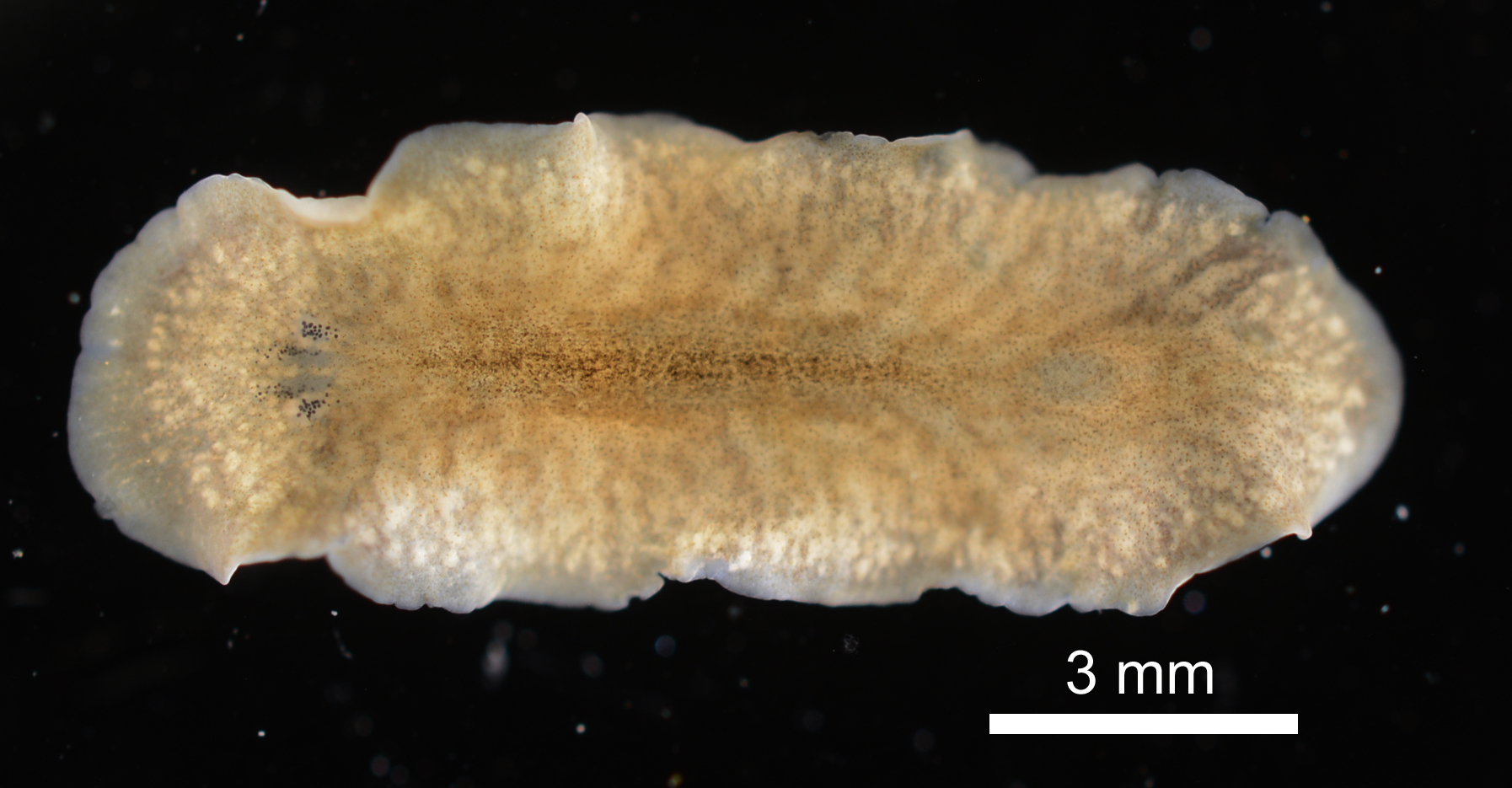A flat worm was collected from among byssi of the bivalves Mytilus trossulus Gould, 1850 and Septifer virgatus (Wiegmann, 1837) in the intertidal zone of Oshoro Bay, Hokkaido, Japan, about 43°12&min;N,140°51&min;E, on 5 May 2015 by Sumika Otake. The specimen was photographed and fixed in 99% EtOH by Shinri Tomioka, and later identified by Yuki Ohya based on the photographs and the sequence as possibly representing an undescribed species in the genus Melloplana Faubel, 1983 [Notoplana Laidlaw, 1903 sensu Prudhoe (1985)]. Total DNA was extracted from the posterior portion of the body using the silica method (Boom et al. 1990) with some modifications. Extracted DNA was dissolved in 30 µl of deionized water and has been preserved at –20°C. Remaining morphological voucher specimen has been deposited at the Hokkaido University Museum under the catalogue number ICHU2130753 (contact: Dr. Hiroshi Kajihara, kazi@mail.sci.hokudai.ac.jp).
PCR amplification was attempted with the primer pairs LoboF1 (5′-KBTCHACAAAYCAYAARGAYATHGG-3′) and LoboR1 (5′-TGTTTYTTYGGWCAYCCWGARGTTTA-3′) (Lobo et al. 2013) for the mitochondrial cytochrome c oxidase subunit I gene (COI) and 16S ar-L (5′-CGCCTGTTTATCAAAAACAT-3′) and br-H (5′-CCGGTCTGAACTCAGATCACGT-3′) (Palumbi et al. 1991) for the 16S rRNA gene. PCR products were visualized by electrophoresis in 1% agarose gel. Of the two gene markers that were attempted, only 16S rRNA gene was confirmed to be successfully amplified. The PCR was performed by a thermal cycler, 2720 Thermal Cycler (Applied Biosystems), in a 20-µl reaction volume containing 1 µl of template total DNA (approximately 10–100 ng) and 19 µl of premix made with 632-µl deionized water, 80-µl Ex Taq Buffer (TaKara Bio), 64-µl dNTP (each 25 mM), 8-µl each primer (each 10 µM), and 0.1-µl TaKara Ex Taq (5 U/µl,TaKara Bio). Thermal cycling condition comprised an initial denaturation at 95°C for 30 sec; 30 cycles of denaturation at 95°C for 30 sec, annealing at 45°C for 30 sec, and elongation at 72°C for 45°C and a final elongation at 72°C for 7 min.
The PCR products of the 16S rRNA gene were purified with the silica method (Boom et al. 1990). Both strands were sequenced with a BigDye® Terminator v3.1 Cycle Sequencing Kit (Applied Biosystems) following the manufacturer's protocol, using the same primer set as the initial PCR amplification. Sequencing was performed with ABI Prism 3730 DNA Analyzer (Applied Biosystems). Chromatogram and sequence data were operated with MEGA v5.2 software (Tamura et al. 2011).
Results
Phylum Platyhelminthes
Class Rhabditophora
Order Polycladida
Genus Melloplana Faubel, 1983
Melloplana sp. indet.
(Fig. 1)
A 448-bp partial sequence of the mitochondrial 16S rRNA gene was determined from ICHU2130753, an unidentified—and possibly undescribed—species in the genus Melloplana Faubel, 1983 (see Appendix). A nucleotide BLAST search (Altschul et al. 1997) at the NCBI website (https://blast.ncbi.nlm.nih.gov/) showed that our sequence from Oshoro was most similar to AB049114 (86% similarity; E value = 1e–126; 100% in query coverage), a 16S rRNA partial sequence of a polyclad flatworm identified as Pseudostylochus intermedius Kato, 1939 (Sato et al 2001).

Fig. 1. An unidentified (and possibly undescribed) species in the genus Melloplana Faubel, 1983 (ICHU2130753) collected among intertidal mussel bed in Oshoro Bay, Hokkaido, Japan, photograph taken in life by Shinri Tomioka.
References
Altschul, S. F., Madden, T. L., Schäffer, A. A., Zhang, J., Zhang, Z., Miller, W., and Lipman, D. J. 1997. Gapped BLAST and PSI-BLAST: a new generation of protein database search programs. Nucleic Acids Research 25: 3389–3402.
Boom, R., Sol, C. J., Salimans, M. M., Jansen, C. L., Wertheim-van Dillen, P. M., and Van der Noordaa, J. 1990. Rapid and simple method for purification of nucleic acids. Journal of Clinical Microbiology 28: 495–503.
Faubel, A. 1983. The Polycladida, Turbellaria. (Proposal and establishment of a new system Part 1. The Acotylea). Mitteilungen aus dem hamburgischen zoologischen Museum und Institut 80: 17–121.
Lobo, J., Costa, P. M., Teixeira, M. A. L., Ferreira, M. S. G., Costa, M. H, and Costa, F. O. 2013. Enhanced primers for amplification of DNA barcodes from a broad range of marine metazoans. BMC Ecology 13:34. DOI: 10.1186/1472-6785-13-34.
Palumbi, S., Martin, A., Romano, S., McMillan, W. O., Stice, L., Grabowski, G. 1991. The Simple Fools Guide to PCR, Ver. 2. Department of Zoology and Kewalo Marine Laboratory, University of Hawaii, Honolulu, 45 pp.
Prudhoe, S. 1985. A Monograph of the Polyclad Turbellaria. Trustees of the British Museum (Natural History), London, iv + 259 pp.
Tamura, K., Peterson, D., Peterson, N., Stecher, G., Nei, M., and Kumar, S. 2011. MEGA5: molecullar evolutionary genetics analysis using maximum likelihood, evolutionary distance, and maximum parsimony methods. Molecular Biology and Evolution 28: 2731–2739.
Sato, K., Sugita, T., Kobayashi, K., Fujita, K., Fujii, T., Matsumoto, Y., Mikami, T., Nishizuka, N., Nishizuka, S., Shojima, K., Suda, M, Takahashi, G., Himeno, H., Muto, A., and Ishida, S. 2001. Localization of mitochondrial ribosomal RNA on the chromatoid bodies of marine planarian polyclad embryos. Development, Growth & Differentiation 43: 107–114.
AppendixA 448-bp partial sequence of the mitochondrial 16S rRNA gene determiend from ICHU2130753, identified as Melloplana sp.
TTCCTTTAGAATATATTTAAAGGTATTGCCTGCcCTATGTTAAATATAAATGGCTGCGGTATCTTAACTGCACTAAGGTAGCATAAttAATTGTCTTTTAAATGGTGACCTGTTTGAATGGCTTAATGAGAAAAAATTTTTCTTATAATTATAATAAAATTATATTTCAAGGTTAAAATACCTGATTATAAAAAAAAGACGAGAAGACCCTGTTGAGTTTAACATTAAATATATAATGTTAAAATGGGAAATTTAACCTTATATTAAGGTTTATTAGATCCTGGGACTATATTAGTCCTGGATATAGGATAAAATTACCACAGGGATAACAGGACAATATTTACTAAGAGTTCTAATCGAAGTAAATGGTTGTTACCTCGATGTTGAATCGAAATATCTTCTTGATGCAGCAGTCAAAGAAGTAGGTCTGTTCGACCTTTTAAATTTC